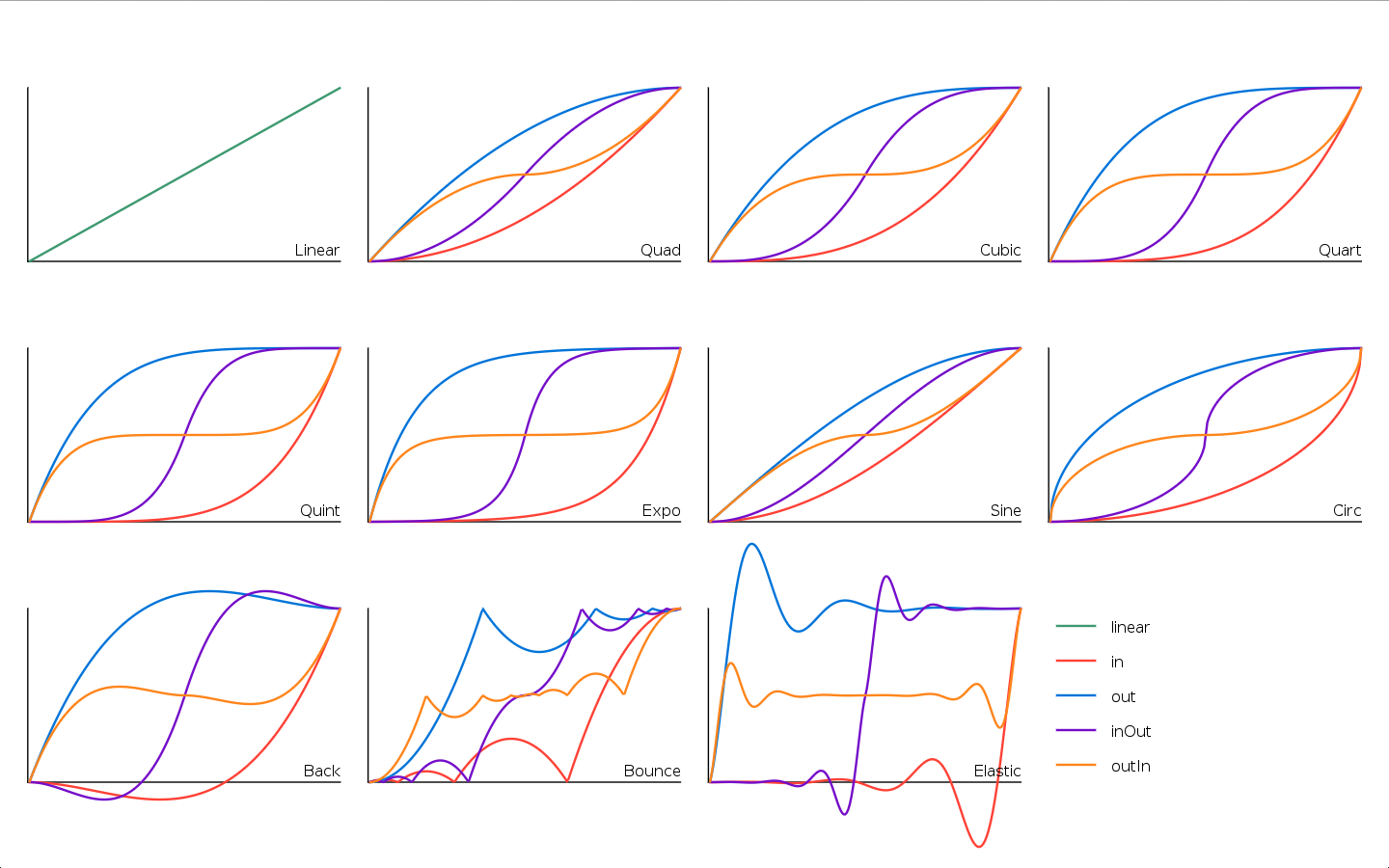https://github.com/kikito/tween.lua
Tweening/Easing/Interpolating functions for lua. Inspired on jQuery's animate method.
https://github.com/kikito/tween.lua
Last synced: 3 months ago
JSON representation
Tweening/Easing/Interpolating functions for lua. Inspired on jQuery's animate method.
- Host: GitHub
- URL: https://github.com/kikito/tween.lua
- Owner: kikito
- License: other
- Created: 2011-04-25T22:23:10.000Z (about 14 years ago)
- Default Branch: master
- Last Pushed: 2023-02-02T00:13:15.000Z (over 2 years ago)
- Last Synced: 2025-03-28T17:06:17.672Z (4 months ago)
- Language: Lua
- Homepage:
- Size: 4.11 MB
- Stars: 616
- Watchers: 25
- Forks: 80
- Open Issues: 5
-
Metadata Files:
- Readme: README.md
- Changelog: CHANGELOG.md
- License: LICENSE.txt
Awesome Lists containing this project
- awesome-love2d - tween.lua - Tweening/Easing/Interpolating functions for Lua inspired on jQuery's animate method. (Tweening)
- awesome-defold - tween
README
# tween.lua
[](https://travis-ci.org/kikito/tween.lua)
[](https://coveralls.io/github/kikito/tween.lua?branch=master)
tween.lua is a small library to perform [tweening](http://en.wikipedia.org/wiki/Tweening) in Lua. It has a minimal
interface, and it comes with several easing functions.
# Examples
```lua
local tween = require 'tween'
-- increase the volume of music from 0 to 5 in 10 seconds
local music = { volume = 0, path = "path/to/file.mp3" }
local musicTween = tween.new(10, music, {volume = 5})
...
musicTween:update(dt)
-- make some text fall from the top of the screen, bouncing on y=300, in 4 seconds
local label = { x=200, y=0, text = "hello" }
local labelTween = tween.new(4, label, {y=300}, 'outBounce')
...
labelTween:update(dt)
-- fade background from white to black and foregrond from black to red in 2 seconds
-- Notice that you can use subtables with tween
local properties = {bgcolor = {255,255,255}, fgcolor = {0,0,0}}
local fadeTween = tween.new(2, properties, {bgcolor = {0,0,0}, fgcolor={255,0,0}}, 'linear')
...
fadeTween:update(dt)
```
# Demo
There is a demo in the "demo" branch of this repo:
https://github.com/kikito/tween.lua/tree/demo

You will need [LÖVE](http://love2d.org) to execute the demo.
In the animation above, you can see how the user can move time "forwards or backwards" by pressing and releasing the space key.
# Interface
## Tween creation
``` lua
local t = tween.new(duration, subject, target, [easing])
```
Creates a new tween.
* `duration` means how much the change will take until it's finished. It must be a positive number.
* `subject` must be a table with at least one key-value. Its values will be gradually changed by the tween until they look like `target`. All the values must be numbers, or tables with numbers.
* `target` must be a table with at least the same keys as `subject`. Other keys will be ignored.
* `easing` can be either a function or a function name (see the easing section below). It's default value is `'linear'`
* `t` is the object that must be used to perform the changes - see the "Tween methods" section below.
This function only creates and returns the tween. It must be captured in a variable and updated via `t:update(dt)` in order for the changes to take place.
## Tween methods
``` lua
local complete = t:update(dt)
```
Gradually changes the contents of `subject` to that it looks more like `target` as time passes.
* `t` is a tween returned by `tween.new`
* `dt` must be positive number. It will be added to the internal time counter of the tween. Then `subject`'s values will be updated so that they approach `target`'s using the selected easing function.
* `complete` is `true` if the tween has reached its limit (its *internal clock* is `>= duration`). It is false otherwise.
When the tween is complete, the values in `subject` will be equal to `target`'s. The way they change over time will depend on the chosen easing function.
If `dt` is positive, the easing will be applied until the internal clock equals `t.duration`, at which point the easing will stop. If it is negative,
the easing will play "backwards", until it reaches the initial value.
This method is roughtly equivalent to `t:set(self.clock + dt)`.
``` lua
local complete = t:set(clock)
```
Moves a tween's internal clock to a particular moment.
* `t` is a tween returned by `tween.new`
* `clock` is a positive number or 0. It's the new value of the tween's internal clock.
* `complete` works like in `t:update`; it's `true` if the tween has reached its end, and `false` otherwise.
If clock is greater than `t.duration`, then the values in `t.subject` will be equal to `t.target`, and `t.clock` will
be equal to `t.duration`.
``` lua
t:reset()
```
Resets the internal clock of the tween back to 0, resetting `subject`.
* `t` is a tween returned by `tween.new`
This method is equivalent to `t:set(0)`.
# Easing functions
Easing functions are functions that express how slow/fast the interpolation happens in tween.
`tween.lua` comes with 45 default easing functions already built-in (adapted from [Emmanuel Oga's easing library](https://github.com/EmmanuelOga/easing)).

The easing functions can be found in the table `tween.easing`.
They can be divided into several families:
* `linear` is the default interpolation. It's the simplest easing function.
* `quad`, `cubic`, `quart`, `quint`, `expo`, `sine` and `circle` are all "smooth" curves that will make transitions look natural.
* The `back` family starts by moving the interpolation slightly "backwards" before moving it forward.
* The `bounce` family simulates the motion of an object bouncing.
* The `elastic` family simulates inertia in the easing, like an elastic gum.
Each family (except `linear`) has 4 variants:
* `in` starts slow, and accelerates at the end
* `out` starts fast, and decelerates at the end
* `inOut` starts and ends slow, but it's fast in the middle
* `outIn` starts and ends fast, but it's slow in the middle
| family | in | out | inOut | outIn |
|-------------|-----------|------------|--------------|--------------|
| **Linear** | linear | linear | linear | linear |
| **Quad** | inQuad | outQuad | inOutQuad | outInQuad |
| **Cubic** | inCubic | outCubic | inOutCubic | outInCubic |
| **Quart** | inQuart | outQuart | inOutQuart | outInQuart |
| **Quint** | inQuint | outQuint | inOutQuint | outInQuint |
| **Expo** | inExpo | outExpo | inOutExpo | outInExpo |
| **Sine** | inSine | outSine | inOutSine | outInSine |
| **Circ** | inCirc | outCirc | inOutCirc | outInCirc |
| **Back** | inBack | outBack | inOutBack | outInBack |
| **Bounce** | inBounce | outBounce | inOutBounce | outInBounce |
| **Elastic** | inElastic | outElastic | inOutElastic | outInElastic |
When you specify an easing function, you can either give the function name as a string. The following two are equivalent:
```lua
local t1 = tween.new(10, subject, {x=10}, tween.easing.linear)
local t2 = tween.new(10, subject, {x=10}, 'linear')
```
But since `'linear'` is the default, you can also do this:
```lua
local t3 = tween.new(10, subject, {x=10})
```
## Custom easing functions
You are not limited to tween's easing functions; if you pass a function parameter in the easing, it will be used.
The passed function will need to take 4 parameters:
* `t` (time): starts in 0 and usually moves towards duration
* `b` (begin): initial value of the of the property being eased.
* `c` (change): ending value of the property - starting value of the property
* `d` (duration): total duration of the tween
And must return the new value after the interpolation occurs.
Here's an example using [LÖVE's Bezier Curve](https://love2d.org/wiki/BezierCurve) (you will need LÖVE for this example, but tween.lua does not need LÖVE in general).
``` lua
local cubicbezier = function (x1, y1, x2, y2)
local curve = love.math.newBezierCurve(0, 0, x1, y1, x2, y2, 1, 1)
return function (t, b, c, d) return c * curve:evaluate(t/d) + b end
end
local label = { x=200, y=0, text = "hello" }
local labelTween = tween.new(4, label, {y=300}, cubicbezier(.35, .97, .58, .61))
```
# Gotchas / Warnings
* `tween` does not have any defined time units (seconds, milliseconds, etc). You define the units it uses by passing it a `dt` on `tween.update`. If `dt` is in seconds, then `tween` will work in seconds. If `dt` is in milliseconds, then `tween` will work in milliseconds.
* `tween` can work on deeply-nested subtables (the "leaf" values have to be numbers in both the subject and the target)
# Installation
Just copy the tween.lua file somewhere in your projects (maybe inside a /lib/ folder) and require it accordingly.
Remember to store the value returned by require somewhere! (I suggest a local variable named tween)
``` lua
local tween = require 'tween'
```
You can of course specify your own easing function. Just make sure you respect the parameter format.
# Specs
This project uses [busted](http://olivinelabs.com/busted/) for its specs. In order to run them, install busted, and then execute it on the top folder:
```
busted
```
# Credits
The easing functions have been copied from EmmanuelOga's project in
https://github.com/emmanueloga/easing
See the LICENSE.txt file for details.
# Changelog
See CHANGELOG.md for a full list of changes.